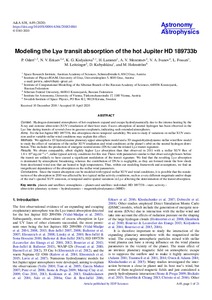Показать сокращенную информацию
Modeling the Lyα transit absorption of the hot Jupiter HD 189733b=Modeling the Ly alpha transit absorption of the hot Jupiter HD 189733b
| Автор | Odert, P. | |
| Автор | Erkaev, N. V. | |
| Автор | Kislyakova, K. G. | |
| Автор | Lammer, H. | |
| Автор | Mezentsev, A. V. | |
| Автор | Ivanov, V. A. | |
| Автор | Fossati, L. | |
| Автор | Leitzinger, M. | |
| Автор | Kubyshkina, D. | |
| Автор | Holmström, M. | |
| Дата внесения | 2021-08-13T09:33:39Z | |
| Дата, когда ресурс стал доступен | 2021-08-13T09:33:39Z | |
| Дата публикации | 2020-06 | |
| Библиографическое описание | Odert, P. Modeling the Lyα transit absorption of the hot Jupiter HD 189733b=Modeling the Ly alpha transit absorption of the hot Jupiter HD 189733b [Текст] / P. Odert, N. V. Erkaev, K. G. Kislyakova, H. Lammer, A. V. Mezentsev, V. A. Ivanov, L. Fossati, M. Leitzinger, D. Kubyshkina, M. Holmström // ASTRONOMY & ASTROPHYSICS. — 2020. — № 638. — С. 1-21 | |
| ISSN | 14320746 | |
| URI (для ссылок/цитирований) | https://www.aanda.org/articles/aa/abs/2020/06/aa34814-18/aa34814-18.html | |
| URI (для ссылок/цитирований) | https://elib.sfu-kras.ru/handle/2311/142953 | |
| Аннотация | Context. Hydrogen-dominated atmospheres of hot exoplanets expand and escape hydrodynamically due to the intense heating by the X-ray and extreme ultraviolet (XUV) irradiation of their host stars. Excess absorption of neutral hydrogen has been observed in the Lyα line during transits of several close-in gaseous exoplanets, indicating such extended atmospheres. Aims. For the hot Jupiter HD 189733b, this absorption shows temporal variability. We aim to study if variations in stellar XUV emission and/or variable stellar wind conditions may explain this effect. Methods. We applied a 1D hydrodynamic planetary upper atmosphere model and a 3D magnetohydrodynamic stellar wind flow model to study the effect of variations of the stellar XUV irradiation and wind conditions at the planet’s orbit on the neutral hydrogen distribution. This includes the production of energetic neutral atoms (ENAs) and the related Lyα transit signature. Results. We obtain comparable, albeit slightly higher Lyα absorption than that observed in 2011 with a stellar XUV flux of 1.8x10^4 erg cm^-2 s^-1, rather typical activity conditions for this star. Flares with parameters similar to that observed eight hours before the transit are unlikely to have caused a significant modulation of the transit signature. We find that the resulting Lyα absorption is dominated by atmospheric broadening, whereas the contribution of ENAs is negligible, as they are formed inside the bow shock from decelerated wind ions that are heated to high temperatures. Thus, within our modeling framework and assumptions, we find an insignificant dependence of the absorption on the stellar wind parameters. Conclusions. Since the transit absorption can be modeled with typical stellar XUV and wind conditions, it is possible that the nondetection of the absorption in 2010 was affected by less typical stellar activity conditions, such as a very different magnitude and/or shape of the star’s spectral XUV emission, or temporal and/or spatial variations in Lyα affecting the determination of the transit absorption. | |
| Тема | planets and satellites: atmospheres – planets and satellites: individual: HD 189733b – stars: activity – | |
| Тема | ultraviolet: planetary systems – hydrodynamics – magnetohydrodynamics (MHD) | |
| Название | Modeling the Lyα transit absorption of the hot Jupiter HD 189733b=Modeling the Ly alpha transit absorption of the hot Jupiter HD 189733b | |
| Тип | Journal Article | |
| Тип | Journal Article Preprint | |
| Страницы | 1-21 | |
| Дата обновления | 2021-08-13T09:33:39Z | |
| DOI | 10.1051/0004-6361/201834814 | |
| Институт | Политехнический институт | |
| Подразделение | Кафедра прикладной механики | |
| Журнал | ASTRONOMY & ASTROPHYSICS | |
| Квартиль журнала в Scopus | Q1 | |
| Квартиль журнала в Web of Science | Q1 |

